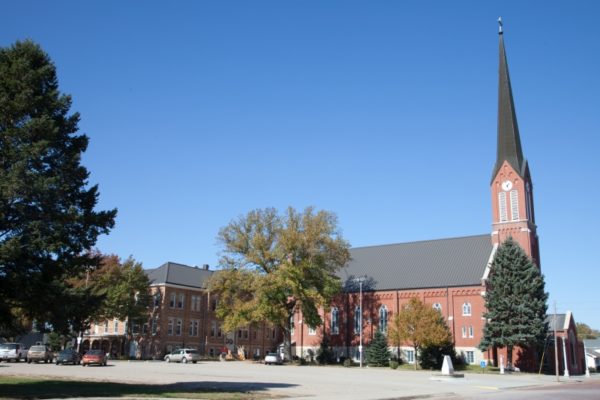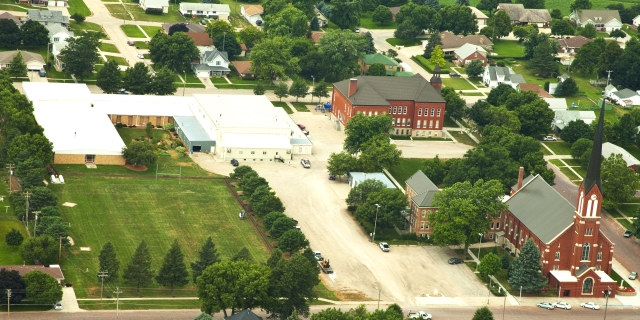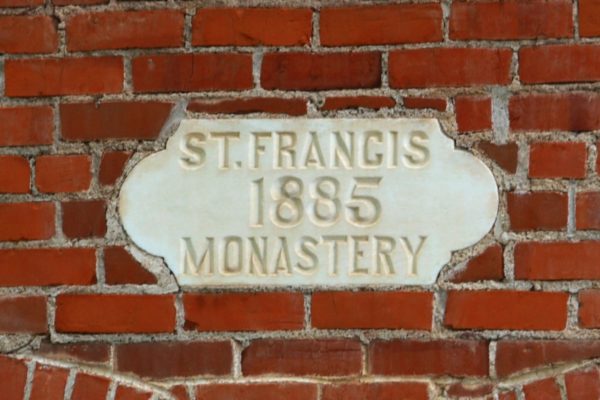In 1879, a branch line of the Union Pacific Railroad was built from Duncan to Sioux City. Humphrey was a direct result of this railroad settlement. Since the railroad didn’t pass through the St. Mary settlement, Catholics were finding the trip to St. Mary Parish troublesome, especially in bad weather.
In 1881, Humphrey residents petitioned the Bishop for a church of their own. The request was turned down. When the school at St. Mary Parish had to be enlarged because so many students were coming from Humphrey, the people again requested a parish of their own. On October 1, 1882, Fr. Theodore Arentz, O.F.M., pastor of St. Mary, announced that permission was granted by the Bishop and Franciscan Provincial to build a church in Humphrey.
The original church frame was 32x64x16 feet with a 64 foot steeple. The church was dedicated on July 10, 1883. Due to the building of the school, the population increased and the church became too small. The building was cut in the middle and the west part was moved out and the intervening space filled in.
In 1888, the parish had 180 families and again, the church was too small. It was decided at this time to build a new church. Since the new church was to occupy the site of the old church, the frame of the church was moved a few hundred feet to the west and used for services while the new one was being build. This Romanesque church was 64×172 with a steeple of 172 feet. Its seating capacity was 800.
The tower of this church was ideal for a town clock so at the request of the citizens of Humphrey, a large tower clock was installed in April 1899. In 1922, new shingles were put on the roof of the church at a cost of $1,734. On September 26, 1945, a bolt of lightning struck the church tower. Had it not been for the lightning rod, there might not have been a tower left. It burned out all the sockets of the tower lights and some sections of the electric wire.
In May of 1956, the cross and ball atop the church steeple was removed and gilded. The cross is seven feet two inches tall and the ball is three feet high. From the bottom of the ball to the ground it was 162 feet. The cost of the gold leaf was $639. On August 9, 1962 at 4:00 a.m., lightning struck the base of the wooden part of the steeple, causing a fire that burned out of control. The upper part of the steeple, half burnt, was blown onto the roof of the church. Fortunately, it landed on one of the strong joist supports and did little damage to the roof. Had it not hit such a support, it would have fallen through the roof and the church would have been lost. The clock mechanism was not harmed by the fire, but the clock faces were burned out. Insurance covered the $13,000 loss.
On December 8, 1963, the church steeple was finally repaired and rebuilt; the workmen put the hands on the clocks as the final touch. On October 15, 1968, lightning again struck the church tower. This time no fire damage incurred and total damage amounted to $498.67, which insurance covered. In 1970, the church bells were electrified so that both bells and clock would ring automatically. In February 1971, lightning again struck the church tower, affecting clocks, bells, the loud speaking system, and some wiring in the church basement.
During the summer of 1971, the north entrance of the church was built, along with a bathroom. In September of 1973 the elm trees in front of church had to be removed because of Dutch Elm disease. In 1977 it was found that the fire of 1962 had done more damage than originally thought. All loose mortar and brick were repaired on the church tower. A new steel A frame support was erected to relieve the pressure of the tower as well. Thermo glass storm windows were installed in the summer of 1978. Screens and hoppers were installed on the 13 large windows in the body of the church. The wood was painted after the old storm windows were removed.
Work started on October 1, 1979, with the concrete in front of church being broken up and removed, to begin enclosing the front entrance of the church. On November 9, 1984, lightning struck the church, friary, and martin house in the garden. It knocked out the public address system in church. In the fall of 2005, tuckpointing and brick repairs were done on the church through the institution of a Building and Repair Fund. Weathered and deteriorated bricks and grout were removed, replaced with new, and a water-repellant sealer was put on for longer life. Loose bricks in the steeple were replaced and the clocks were repainted. A new steel roof was installed on the church in 2006.








